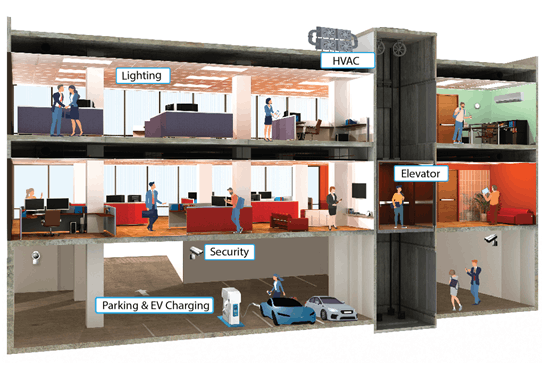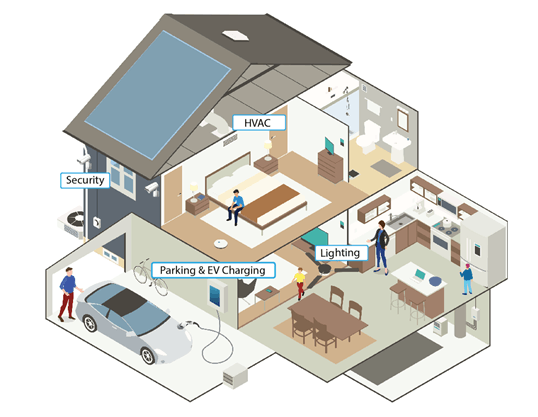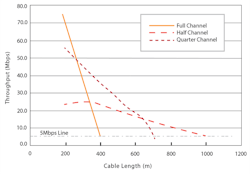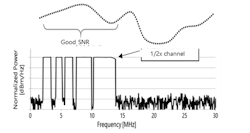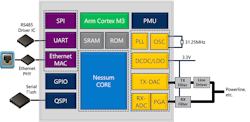Nessum Simplifies Building Automation for Commercial and Residential Structures
Formerly known as HD-PLC, the versatile Nessum standard provides a communications foundation for an integrated building automation strategy that will meet the emerging comfort and security requirements of building tenants. As expectations increase, the design of services and systems in buildings must adapt. Buildings must then be managed efficiently to keep costs in line.
Building Services
Structures that offer optimal efficiency, comfort, and safety will command the highest rents and occupancy rates. Building control systems, including lighting, HVAC, and security play a crucial role in managing and optimizing the environment, and the Nessum standard provides an excellent path to a fully integrated building automation strategy.
Examples of building control applications include:
- Lighting. Lighting control systems adjust lighting levels based on occupancy, time of day, and natural light availability. These can reduce energy consumption by turning off lights in unoccupied areas or dimming them when sufficient daylight is present.
- HVAC (Heating, Ventilation, and Air Conditioning). HVAC systems monitor temperature, humidity, and air quality. They optimize heating and cooling based on occupancy patterns and external weather conditions, maintaining comfort while minimizing energy usage.
- Building Security. Building access control systems manage entry points and track movement within the building. They enhance security by granting access only to authorized personnel. CCTV systems provide real-time surveillance and recording, enhancing security by monitoring critical areas and detecting intruders. Electronic displays present day-to-day communications and can present security information (for example, directions to emergency exits) when required. Two-way audio systems facilitate communication between building occupants and management and emergency services.
- Elevators. Elevator control systems manage the dispatch of elevators to optimize the throughput of occupants from one floor to another while providing a comfortable and safe environment. They signal the location and availability of elevators, and provide security, maintenance, and communications services.
- Parking and EV (Electric Vehicle) Charging. Parking systems monitor the occupancy of the parking facility and indicate the availability of empty stalls. They can also monitor pedestrian traffic. Charging systems can monitor and control EV chargers.
Challenges of Existing Communications Technologies
Control systems generally have evolved as individual services. The communication between equipment and controller has been point-to-point, the data rates have been low, and the protocol is either proprietary or one of many protocols designed for point-to-point communication. Several network-oriented communications technologies are now being used for some in-building communication. However, they each have disadvantages that limit their application. Ethernet is used for wired data distribution, but the cable is costly and expensive to install. Its range is also limited to 100-meter segments. Its use is generally limited to the provision of broadband data services, as well as backhaul for Wi-Fi access points and narrow use cases such as security cameras. Wireless technologies like Wi-Fi and Bluetooth overcome some of the installation issues of Ethernet but suffer from gaps in coverage and are not as robust as wired technologies. Trying to overcome this may result in the over-provision of hubs and access points. Furthermore, the use of wireless technologies introduces the need to separately wire the clients to a power source to minimize the risk of failure. To move towards more efficient and effective delivery of building services, a communications system that can holistically address control across all these capabilities with appropriate capacity and range using standardized network-oriented protocols is needed.
Nessum: A Holistic Communications Technology for Buildings
The technologies underlying Nessum (formerly known as HD-PLC) provide robust data services to a wide variety of terminals at the lowest cost. Since the terminals must usually be wired to a power source, transmitting the data over the power lines is the most effective way to achieve this.
Nessum uses frequencies between 2 and 28 MHz, allowing powerline communication under various standards, such as CENELEC EN 50561-1. It supports different channel widths, allowing users to trade off data throughput and range.
When narrower channels are used, the network conditions can be analyzed, and the most appropriate channel can be used. Nessum also supports the “notching” of channels to prevent interference with other radiators using the band or to comply with regional regulations.
Nessum is standardized as IEEE 1901-2020, which specifies the medium access protocol and modulation for broadband powerline systems and an inter-services protocol for interference management. It also specifies the use of AES-128-based link encryption for secure communication.
Additionally, it supports ITU-T Recommendation G.9905, a robust and low-overhead multi-hop routing protocol that enables large-scale networks. The Nessum implementation supports up to 10 hops over up to 1024 nodes, yielding a maximum range of 10 Km.
In multi-hop, each device can act as a repeater. The centralized metric-based source routing (CMSR) protocol determines the best routes between devices. If a device goes offline and is unavailable for hopping, the network will be reconfigured automatically using the available devices, ensuring a seamless connection.
Socionext SC1320A Nessum Interface Device
The Socionext SC1320A device has integrated Nessum medium access control (MAC) and physical (PHY) layers. It implements a bridge between Nessum and Ethernet and also allows the connection of a variety of external peripherals using industry-standard interfaces such as SPI and UART, and general-purpose I/O. It supports secure boot from the external serial Flash ROM via a Quad SPI interface.
It is available in a compact 7mm x 7mm package, operates within the industrial temperature range, and requires a single 3.3V power supply. Power consumption is less than 200 mW.
Learn more about the SC132A Nessum interface device and the Nessum Alliance.

